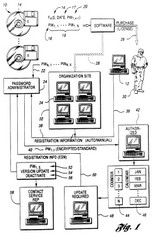 I’m writing a paper on this very topic, but history is happening faster than I can type . . .
I’m writing a paper on this very topic, but history is happening faster than I can type . . .
z4 Technologies, Inc. v. Microsoft (E.D.Texas 2006)
z4 Tech appears to be the first post-eBay decision denying a permanent injunction after a patent has been valid and infringed. Here, the jury found that the patents were willfully infringed by Microsoft and that there was insufficient evidence to find the patents invalid. z4 then asked the Court to enjoin Microsoft from making, using, or selling its infringing product (Windows XP).
The Court followed the “traditional four-factor test used by courts of equity.” to determine whether to issue an injunction:
I. Irreparable Injury to Patentee: The patentee argued that infringement of a patent created a rebuttable presumption of irreparable harm to the patentee. The district court dismissed this “creative” argument as lacking precedential foundation:
z4's arguments for the application of a presumption of irreparable harm are creative, but z4 cannot cite to any Supreme Court or Federal Circuit case that requires the application of a rebuttable presumption of irreparable harm with regard to a permanent injunction.
In fact, the court cited the Supreme Court case of Amoco Production for the proposition that a presumption of irreparable harm in the context of an injunction is “contrary to traditional equitable principles.”
Because z4 does not create any products, the Court found that z4 the first factor weighed in favor of the willful infringer, Microsoft.
In the absence of a permanent injunction against Microsoft, z4 will not suffer lost profits, the loss of brand name recognition or the loss of market share because of Microsoft’s continued sale of the infringing products. These are the type of injuries that are often incalculable and irreparable. The only entity z4 is possibly prevented from marketing, selling or licensing its technology to absent an injunction is Microsoft. As . . . z4 can be compensated for any harm it suffers in the way of future infringement at the hands of Microsoft by calculating a reasonable royalty for Microsoft’s continued use of the product activation technology. Accordingly, z4 has not demonstrated that it will suffer irreparable harm absent a permanent injunction.
II. Remedies Available at Law (Is Money Sufficient?): Here, the court cited Kennedy’s concurring opinion from eBay:
Justice Kennedy specifically mentioned the situation where a “patented invention is but a small component of the product the companies seek to produce” and states that in such a situation, “legal damages may well be sufficient to compensate for the infringement and an injunction may not serve the public interest.” . . .
Here, product activation is a very small component of the Microsoft Windows and Office software products that the jury found to infringe z4's patents. The infringing product activation component of the software is in no way related to the core functionality for which the software is purchased by consumers. Accordingly, Justice Kennedy’s comments support the conclusion that monetary damages would be sufficient to compensate z4 for any future infringement by Microsoft.
In addition, Microsoft has promised that its new version of Windows (2007) will phase out all the infringing components. Thus, any ongoing royalty would only last for a couple of years. “For the reasons stated above, z4 has not demonstrated that monetary damages are insufficient to compensate it for any future infringement by Microsoft.”
III. Balance of Hardships: Microsoft argued that it would be really hard to redesign even a small component of Microsoft office. From what I have heard about the complicated code noodle, that assertion must be true. Thus, the court found that the balance of the hardships weigh in favor of Microsoft.
IV. Public Interest: Microsoft office is really popular, and “it is likely that any minor disruption to the distribution of the products in question could occur and would have an effect on the public due to the public’s undisputed and enormous reliance on these products. . . . Although these negative effects are somewhat speculative, such potential negative effects on the public weigh, even if only slightly, against granting an injunction.”
Commentary: As I predicted earlier, one way to avoid an injunction is to be a very successful infringer. I would have suspected that Microsoft’s willfulness would have weighed in z4’s favor, but the court did not even mention willfulness in its analysis of the equitable relief factors.
In a forthcoming paper code-named Injunction Denied, I address the issue of injunctive and monetary relief in patent cases. In particular, I focus on the situation where equities favor the defendant, and ask the question what monetary remedy a court should then impose? My answer may surprise you. . .